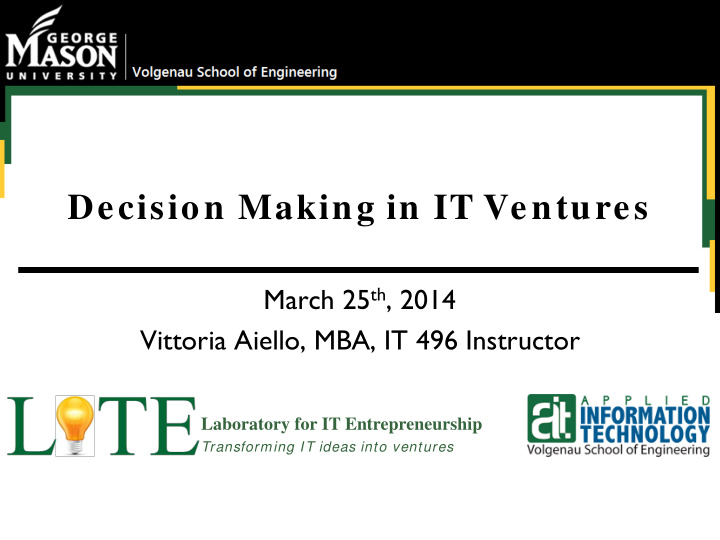



Decision Making in IT Ventures March 25 th , 2014 Vittoria Aiello, MBA, IT 496 Instructor Laboratory for IT Entrepreneurship Transforming IT ideas into ventures
Agenda Definition of Decision Making Key steps in the Decision Making Process Decision Making Process applied to assessing a business idea Peculiarities of the IT industry and decision making in IT IT 496 “Decision Making in IT ventures” – Fall 2014 Q&A / Wrap up 2
Decision Making: Definitions “The thought process of selecting a logical choice from the available options” Business dictionary “Decision making is the process of identifying and selecting a course of action to solve a specific problem” James Stoner “Decision making involves the selection of a course of action from among two or more possible alternatives in order to arrive at a solution for a given problem” Trewartha and Newport 3
Decision Making – Starting a Business 4
Decision Making Applied to Creating a Business 5
Key Steps in the Decision Making Process Starting a new business Define the Identify the Make a List the Determine problem outcomes decision alternatives the payoffs 6
Step 1: Clearly Define the Problem What is (are) the problem(s)/need(s) you are trying to address? – Identify unsolved problem(s)/need(s) customers are experiencing – Why are they still unsolved? • technology not mature enough? • new problem? • market too small? – Expressed needs – Unexpressed needs 7
What does a man in the desert need the most? 8
Step 2: List the Possible Alternatives How are you going to solve the problem(s) or satisfy the need(s)? – Create a new product/service – Improve an existing product/service 9
Identifying the Resources Needed Creating a new Improving an existing product/service product/service Resources needed Services Skills Floor space Equipment Time 10
Analyzing the Alternatives New product/service? Yes No Who are your What is unique Who are your competitors? Is it patentable? about your competitors? product? Feature, price, Proof of Patent search quality concepts/estimate Benefits to the customers 11
Step 3: Identify the Possible Outcomes Possible outcomes Unfavorable market Favorable market (people will not buy your (people will buy your product) product) 12
Will People Buy Your Product/ Service? Identify value/benefits for the customers Identify your target – who will buy your product/service Identify the right price 13
Identify Value/ Benefits for the Customers Measurable – For example , a product that helps the customer save money Non-measurable – Enjoyment that a customer receives from a product or service in the face of the paid price 14
Defining a Value Proposition VALUE PROPOSITION (the business’ promise of value to be delivered to the customer) Quantified Relevancy Differentiation Value Specific benefits Why customers How your product delivered to the should buy from solves customers’ customers? you problems? 15
Value Proposition – Examples The party is over for thieves. Prey lets you keep track of your laptop, phone and tablet whenever missing, whether you're in town or abroad. Open source, proven software with hundreds of documented recoveries all around the world. http://preyproject.com/ Send beautiful email newsletters. Campaign Monitor makes it easy to attract new subscribers, send them beautiful email newsletters and see stunning reports on the results. http://www.campaignmonitor.com/ 16
Who Will Buy Your Product/ Service? Who will buy your product/service? Consumer Business/ Market Organization Age, gender, Industry, size, annual income, spending sales, suppliers, habits, goals customers 17
Customer Profile Why should you create a customer profile? – Understanding why customers may want to buy from you – Segmenting your market • Target customer groups with different offers tailored to their specific needs – Making it easier to find new customers • Look for similar prospects 18
Steps in Creating a Customer Profile Describe your customers’ key features – Demographics (age, gender, income, educational background, etc.) – Psychographics (personality, interests, lifestyle and values) Locate your customers – Where are your customers (geographical area) Understand their buying process – Where do they start their search? – What are the specific needs of each segment? – What benefits are they looking for? – What motivates them? • convenience, customer service, price and promotions 19
Identifying the Right Price What price are your competitors (direct and indirect) charging? How much are your customers able/willing to pay for your product/service? Is it profitable? – How much does the product cost to you? – What are the revenue streams (one or multiple)? 20
Step 4: Determine the Payoffs Estimate your sales for the 1 st year of operation Factors to consider: – Market size – Geographic area – Level of competition Market share – Price – Plans for promotion – Growth potential (trends in your market/industry) – Capacity of your operations in the first year – Seasonal factors Scenarios: pessimistic, optimistic, and realistic 21
Step 4: Determine the Payoffs (cont’d) Estimate your costs Resources needed & costs Creating a new Improving an existing product/service product/service Inventory (products) Skills Equipment/supplies Floor space Services needed(i.e. consulting, legal) Time Other (i.e. incorporation fees, insurance) 22
Step 4: Determine the Payoffs (cont’d) List the payoffs and make your decision Alternatives Pessimistic Optimistic Realistic scenario scenario scenario Create a new product/service -50,000 150,000 90,000 Improve an existing product/service -20,000 80,000 40,000 23
IT Industry and Decision Making Peculiarities of the IT Industry 24
IT industry - Peculiarities Cost Structure Cost Structure Pricing High fixed costs Strategies Zero/near zero variable costs 25
IT industry – Peculiarities (cont’d) Rapid Technological Progress Shorter Rapid Marketing Product Life- Technological Strategies Cycle (quick growth Progress stage and sharp decline) 26
IT industry – Peculiarities (cont’d) Network Effects Network Competition Effects 27
IT 496 -“Decision Making in IT Ventures” Content: decision making processes; evaluating the impact and outcomes of decisions in IT ventures Format: team centered; hands-on approach – teams will be required to complete a specific phase of their business creation process When : Fall 2014 Where : Prince Williams Campus – BRH 249 Day/Time: Thursdays – 4:30 to 7.10 More info and Syllabus: – http://lite.gmu.edu/courses/2014-FALL-IT496/ 28
29
Recommend
More recommend